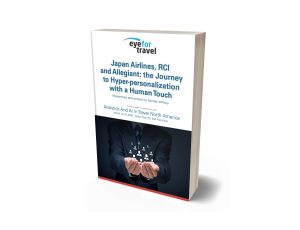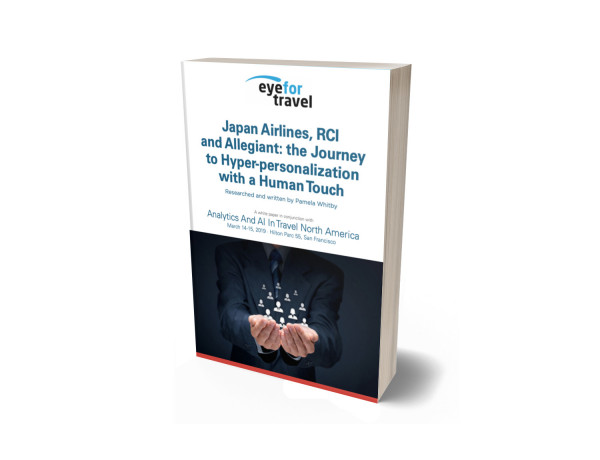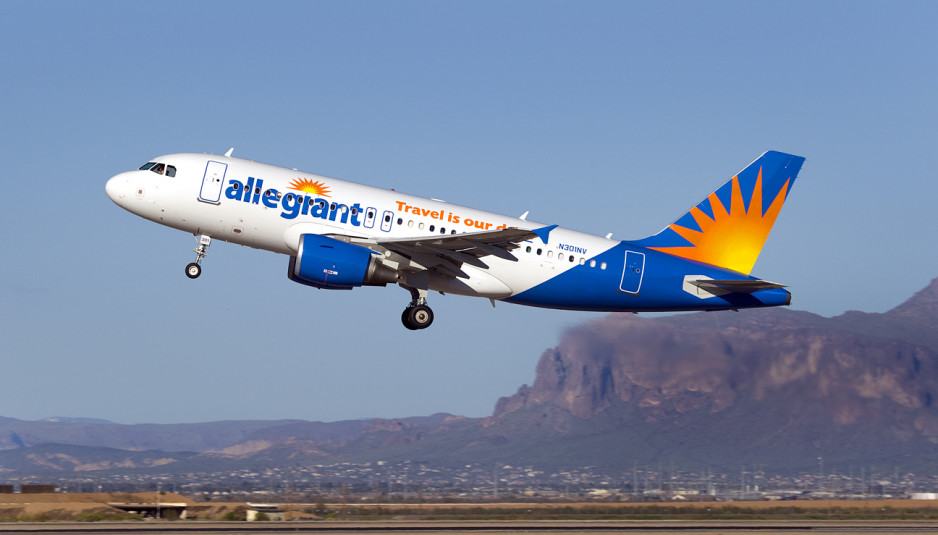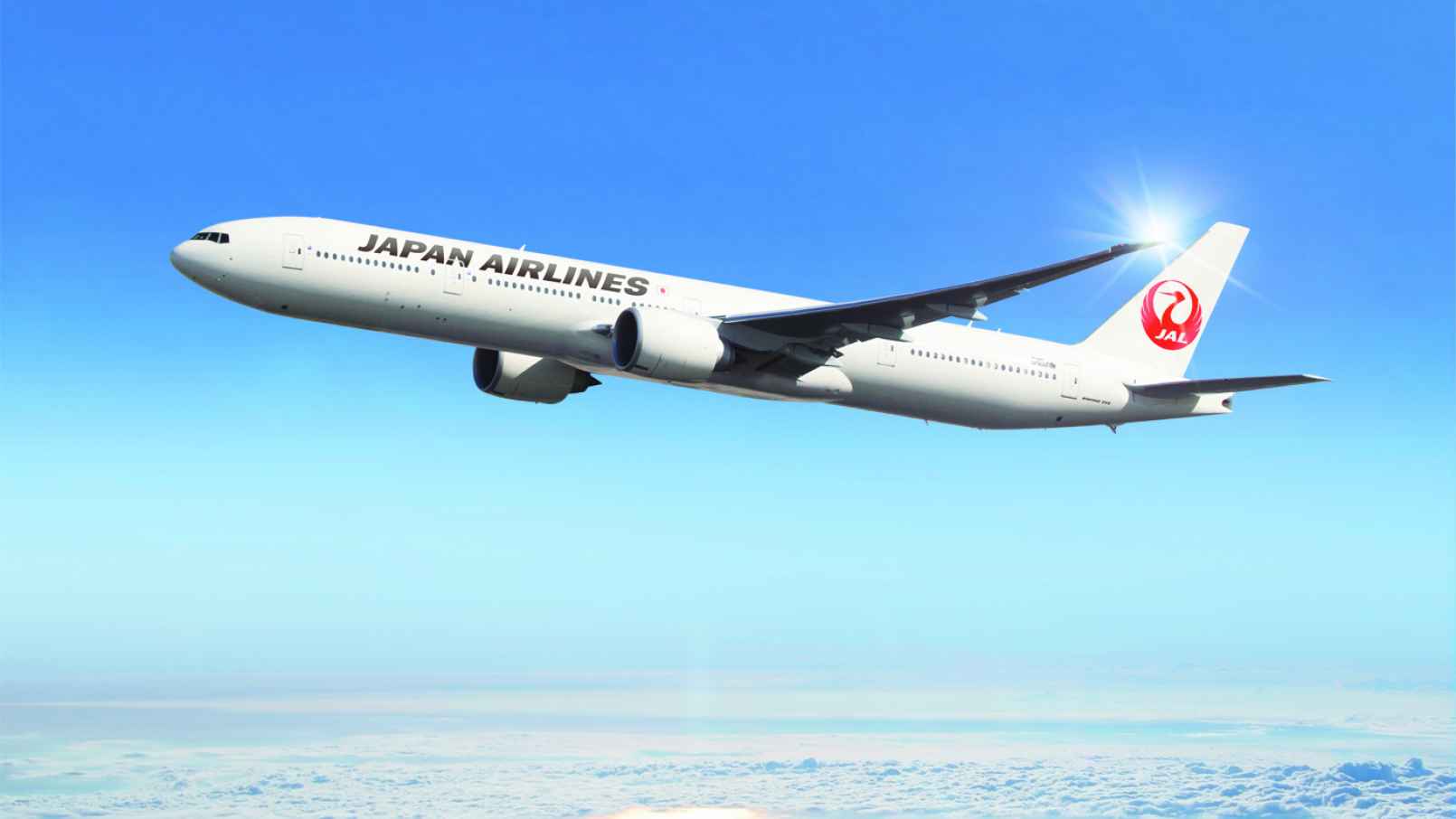Whitepaper: How Japan Airlines, Wyndham & Allegiant master hyper-personalization
Learn about hyper-personalization – the new industry buzzword, from EyeforTravel‘s new research whitepaper.
Download the whitepaper below, and read on for a summary and key findings presented by Meredith Pistulka, EyeforTravel’s Head of Marketing.
 💻 Download the exclusive whitepaper
💻 Download the exclusive whitepaper
What is hyper-personalization and why is it important?
Hyper-personalization is the ability to not simply target customers in a superficially relevant way but with intelligent, highly tailored real-time offers.
A 2018 report by McKinsey found that 69% of customers are more loyal to a travel company that personalizes their online and offline customer experiences, which indicates that it is certainly worth doing.
How are travel companies using hyper-personalization today?
It’s still very early days for many companies but the idea is that brands will be able to make real-time, highly relevant recommendations to customers based on their previous browsing history.
Here are some examples from the industry:
RCI (a large timeshare company sitting under Wyndham Destinations’ umbrella) recently published its new recommendation engine. Now, when a member logs in, one of the first things they see are data-driven offers for properties that might be of interest.
Like RCI, Japan Airlines sees the hyper-personalization piece as the next step in interacting with customers dynamically to deliver far more relevant recommendations at all stages of the journey, and in real-time.
“We are really changing from being just a mode of transport to becoming a retailer in the true sense of the word. [For instance], we are looking into using facial recognition in some places, but it would be nice to have it everywhere, so that from check-in to passport control and the business lounge, a customer never has to show another document,” says Akira Mitsumasu, VP, Products & Services Planning at Japan Airlines.
At US-based low-cost airline Allegiant, hyper-personalizing is in the early stages of development, says Isaac Mavis, the airline’s Vice President of Data Science. “When someone visits the site and begins to shop for their trip, we want to be able to predict what they are most likely to do at each stage of the booking path, so that we can tailor directly to them,” he says.
For Allegiant, improving the customer experience starts with removing unnecessary obstacles in the booking process. The next step is to make it easier for customers to book favoured items.
How can success in hyper-personalization be measured?
Some of the prerequisites for tracking and measuring success are deploying the right technology, getting data into one place, where it is more easily consumed and setting clear KPIs (such as measuring click-through rates, track if offers are being downloaded and how many times, conversion rates etc.).
RCI, for example, is tracking a number of metrics to understand if its attempts to hyper-personalize are working. Among the questions it looks to answer are:
- Are the right recommendations being shown in the weeks leading up the actual booking?
- Is it a good mix of destinations?
- Has the customer been shown a hidden gem?
- Are they clicking on recommendations?
- How often is a member steered into booking something that they might not have found in a standard search process?
- Are conversions up, and has the member successfully found what they are looking for?
- Is the experience consistent across all channels? (For example, an RCI email should be consistent with what the user is clicking on online)
A simple click rate measure has become one of RCI’s first success metrics as is delivering a consistent multichannel experience.
At Japan Airlines, on the other hand, the main KPI is customer satisfaction, and it uses net promoter score (NPS) tools to gauge this, while also benchmarking performance against other airlines.
 Download the exclusive whitepaper
Download the exclusive whitepaper
What can travel businesses learn from other industries?
Many travel businesses are looking to companies like Amazon, which is already successfully hyper-personalizing – every user is trained on the site, they know exactly who you are and the experience is seamless.
However, while Amazon has set the bar high for hyper-personalization efforts, and remains a potential threat to some parts of the travel industry, it doesn’t have to be the end game.
Jeremy TerBush, SVP Analytics at RCI, says: “We do look to the likes of Amazon and Netflix as the pinnacle of where we want to get to. But the reality is that the data we have about intent of customers still has a way to go.”
He continues: “I don’t believe an RCI member, who typically uses the site once every 1.5 years, expects an Amazon experience. But they do at least expect us to pull together everything we know [about them] and put something in front of them that makes sense based on that information.”
Where’s the line between hyper-personalization and personal data safety concerns?
The line is clear – protecting people’s data must be paramount. However, this is, again early days, and it’s not clear yet how this is going to play out.
In Europe, at least, companies have to take this very seriously thanks to GDPR or they are going to face big fines.
“We want to partner with our customers to make sure they are giving us data they want, and to have us know and understand how we are going to use that to make their vacation planning more seamless and rewarding.” says TerBush.
What are the challenges facing the hyper-personalization concept?
Everybody agrees that this is not an easy thing to do. McKinsey’s recent report finds that most major airlines today still struggle to provide customers with complete, easy to use digital services. Among the 25 major airlines it assessed, ‘none excelled’.
For RCI, part of the challenge is to “capture information in real-time and actually process it and come back with something that is smart and makes sense to customers. Getting to the point of having a proof of concept and a minimum viable product requires a fair amount of foundational work.”
Japan Airlines acknowledges the challenges and is looking for solutions outside of the organization. The carrier is looking into using white-label solutions from third parties to personalize the travel experience, and to package offers in a more dynamic way.
In the end, it’s about understanding a businesses own unique landscape, knowing the target audience, acquiring the right technology to do so and, perhaps most importantly of all, continuing to deliver a human touch.
 💻 Download the exclusive whitepaper
💻 Download the exclusive whitepaper
👉 Get the brochure for Analytics And AI In Travel North America, taking place in San Francisco on March 14-15, 2019.
👋 This article is archived. Take a look at our new website.



